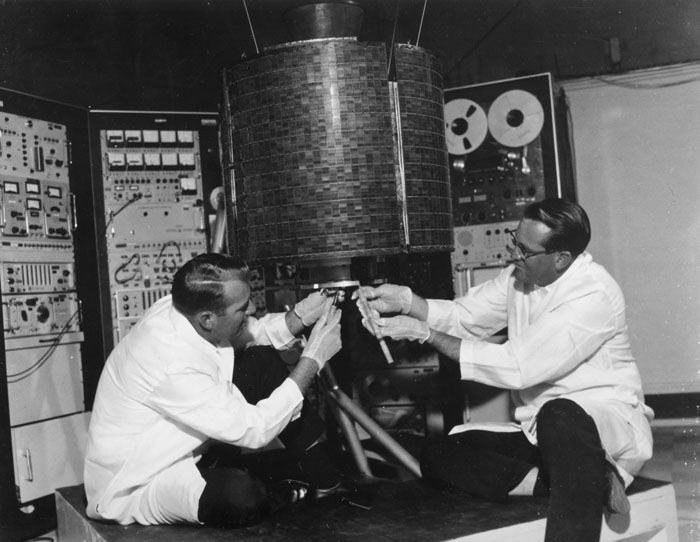Space History Photo: Engineers checkout Early Bird-Communication Satellite

In this historical photo from the U.S. space agency, engineers Stanley R. Peterson (left) and Ray Bowerman (right), checkout the Early Bird, the world's first communication satellite.
NASA launched the satellite built by Hughes Aircraft Corporation on April 6, 1955 at 6:48pm E.S.T. from Complex 17a at Cape Kennedy, Florida. Early Bird was built for the Communications Satellite Corporation and weighed about 85 pounds after being placed in a synchronous orbit of 22,300 miles above the earth. It was positioned over the Atlantic to provide 240 two-way telephone channels or 2-way television between Europe and North America.
The outer surface of Early Bird was covered with 6,000 silicon-coated solar cells, which absorbed the sun's rays to provide power to the satellite for its intricate transmitting and receiving equipment.
Each weekday, SPACE.com looks back at the history of spaceflight through photos (archive).
Get the Space.com Newsletter
Breaking space news, the latest updates on rocket launches, skywatching events and more!
Join our Space Forums to keep talking space on the latest missions, night sky and more! And if you have a news tip, correction or comment, let us know at: community@space.com.

The National Aeronautics and Space Administration (NASA) is the U.S. government agency in charge of the civilian space program as well as aeronautics and aerospace research. Founded in 1958, NASA is a civilian space agency aimed at exploring the universe with space telescopes, satellites, robotic spacecraft, astronauts and more. The space agency has 10 major centers based across the U.S. and launches robotic and crewed missions from the Kennedy Space Center in Cape Canaveral Florida. It's astronaut corps is based at the Johnson Space Center in Houston. To follow NASA's latest mission, follow the space agency on Twitter or any other social channel, of visit: nasa.gov.









